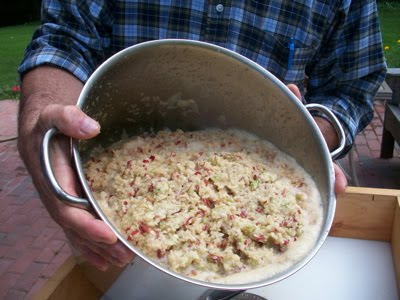
My homemade Whizbang apple grinder (the one I tell how to make in This Book) was developed to easily and quickly mash apples for cider pressing. A kitchen food waste disposal is utilized to do the work. Upon seeing such fine apple mash produced by the machine, an inquiring mind asked if the Whizbang grinder might be employed to produce apple sauce—easily and in large quantity for putting up in canning jars? It was a great question and one my wife and I set out to answer a few days ago.
Macintosh apples are in season here in upstate New York during this mid-month of September. Marlene and I picked a bushel right off the tree at a local orchard and, within the hour, we commenced to making our first batch of Whizbanged applesauce.
We embarked on this little culinary adventure with the understanding that it would be an endeavor of discovery, and that I would report our experiences here... for the good of all homemade-applesauce-loving humanity.
If you are unfamiliar with homemade applesauce, that is a pity. Beyond that, it is a shame. Truly. Please....you must make your own applesauce. Homemade is far superior to all those anemic-looking jars of applesauce you’ll find in the supermarket. Applesauce that has not oxidized brown is simply not natural.
And it is not necessary to add chemicals to “preserve freshness.” Store-bought applesauce with preservatives is no more fresh (and probably a lot less fresh) than homemade. Equally offensive is the addition of high-fructose corn syrup to the mix. It so happens that applesauce with no added sweetener (beyond the natural sweetness of the fruit itself) has its own fine flavor.
Some apple varieties make a more naturally sweet sauce than others, and I understand that Macintosh apples are not necessarily the best variety for sweet sauce. As this apple season progresses, we will get more-suitable apples for homemade applesauce. For our experimental purposes now, the Macs will suffice. Also, I should point out that a mix of apple varieties tends to make better tasting applesauce than just one variety. That is, of course, exactly the same case when making cider.
If you find you must add some sweetness to your applesauce, you can do this after opening the jar. That’s my opinion. Others may disagree. Whatever the case, even white sugar (the bane of all healthy-minded people) is better than high fructose corn syrup. But I digress...
The time-honored way of making applesauce (the way Marlene has made it for more than 20 years) is to wash and quarter the apples, put them in a big pot on the stovetop burner, add a little water to the bottom of the pot, and cook, stirring occasionally, until the apples are soft. Then the soft mix is run through a strainer of some sort.
You can read a very nice online homemade applesauce tutorial At This Link. But it does not tell you how to make Whizbanged applesauce, as you're about to see.
We have a strainer like this that we’ve used to make applesauce in the past. It works pretty well but straining with such a device can be, well, a strain on one’s body. Cranking and cranking the handle around and around, and around and around, gets old fast. It tends to be messy too. Then there’s all that CLEAN UP afterwards! :-(
Can this tedious old process be simplified with the Whizbang apple grinder? Well, let us see....
With simplicity and easy cleanup in mind, I decided to do all of the actual work of turning whole apples into fine applesauce mash outside my back door on the patio. Cleanup is so much easier with a garden hose in your hand.
I began, as this next picture shows, by rinsing the apples in a bucket of water, then piling them in a colander to drip-dry.

Next. I commenced to quarter each apple and used a paring knife to remove the seeds, as you can see in this next picture.

I determined that we would make this first experimental batch of applesauce with the apple skins in the mix. My reasoning being: a) it’s easier & faster to not peel the fruit, b) apple skin is good for you—or so I’ve heard, c) most people, when they eat a raw apple, eat the skin too.
Beyond those reasons, you will never find applesauce-with-the-skins inside those loathsome jars of factory-made applesauce. That in itself is, to my anti-industrial mindset, enough reason for me to leave the skins on. Which brings to mind an idea:
I knew a guy who once wore a t-shirt with the words Question Authority boldly emblazoned on the front. I guess that was a popular saying at one time. I propose a new slogan for the t-shirts of concerned food-eaters....Question Industrial Food.
Oh, another thing about skins in the applesauce: I’m not out to win prizes at the State Fair with this applesauce. My focus is putting up a lot of wholesome, homemade applesauce, quickly, and without a lot of trouble.
And, finally (on this matter of apple skins), it occurs to me that some people reading this might wonder: “Why not then leave the cores, seeds, and, for that matter, stems (perhaps with an occasional leaf) in the applesauce too?” Well, I thought about that and I decided that I’m only anti-industrial, not a total savage. Besides, apple seeds in quantity are said to be poisonous.
I prepared 1/2 bushel of Macs and got two pans full, as shown in this next picture (cores are in the square pan at left):

The next step was to run those apple chunks through my Whizbang apple grinder. Here is a picture of the beautiful device.

First, I ran a couple of gallons of hot water through the grinder to flush out any accumulated dust. Then I ran the chunks through:

It took all of 2.5 minutes to feed half a bushel of cored apple chunks through the grinder, and here was the result:

With the apples thus sauced, before turning our attention to canning, I took a moment to clean out the grinder. A moment is all that's needed. This is where the garden hose comes in handy...

To clean inside the grinder, I just ran it while spraying water inside. I also sprayed the underside of the rubber splash guard.

Here's a picture of the Whizbanged applesauce. You'll notice the texture is far different than typical homemade sauce. This sauce stands up in the spoon! It is more the consistency of chutney.

It was decided that we would raw pack the sauce into pint size canning jars. This next picture shows me using a funnel to direct the mash into the jars.

After that picture was taken, I opted to just fill the jars using a big spoon and that was actually easier (see the picture at the beginning of this essay). The funnel is probably more suited to filling larger jars. When filling the jars, I made sure to pack the sauce down and eliminate any air pockets.
I filled the jars to about 1/2 inch from the top rim, the rim was wiped clean, a lid was set in place, and the jar ring was tightened down.
Raw applesauce in clean-but-not-sterilized jars will not keep for long. It has to be heated up in order to kill off any biological activity and seal the lids. This work of “canning” is typically done with either a hot-water-bath canner or a pressure canner. We decided to use our pressure canner.

I should make it clear that raw-packing applesauce when canning is pretty much unheard of. There are no instructions for this in the Ball Blue Book (by the way, if you go to that link, make sure you check out Paul Noll’s Korean War Stories). If you can anything, you must have a copy of the Ball Blue Book.
When Marlene and I were married (29 years ago!) one of the first things we bought for our homestead was an All American canner. And we didn’t even have a homestead then. We lived in a small apartment in town. But even in that location we started putting food up. I built some shelves in the kitchen and we filled them with canned food. I seem to remember paying almost $100 for the canner back then. That was a lot of money. Now a new one costs twice that. But it was a good-quality tool. Marlene has canned many hundreds of jars of food in that canner and it works as good as the day we got it (but it doesn’t look brand new any more). Amazingly, she found the same canner at a garage sale a few years back for eight dollars. Now, both canners are often in use at the same time.
I’ll not go into the specifics of using a pressure canner here (you can get that information from the Ball Blue Book). Suffice it to say that we pressure canned the nine pint jars the canner holds at ten pounds of pressure for ten minutes.
When the canning was done, we removed the jars and I was disappointed to see that the amount of applesauce shrunk. Each jar was full to the shoulder (about 1-3/4” down from the rim) with moist applesauce, but from there up, there was a “pillar” of dry applesauce. Here’s a picture:

I banged the bottom of the jars against the palm of my hand to settle the dry sauce down. This rendered a truer reading of how much applesauce was actually in each jar.

My question with these not-completely-full jars was: “Where did that 1-1/4” of applesauce go?” It was a mystery. But a little research revealed a likely answer...
I found out that raw food has more oxygen in it than cooked food. So it would appear that pressure cooking eliminated the oxygen in the raw apple mash, and that is why it settled.
You may be wondering how this Whizbanged raw-pack applesauce tasted. Well, we opened a jar right out of the canner, let it cool down a bit, and gave it the official taste test.
The flavor was fine. It tasted like unsweetened applesauce from a not-too-sweet apple is supposed to taste, and I liked it. The texture of the sauce was much coarser than you would get from a typical food strainer. But that was not bad. Just different.
Having little bits of apple skin in the applesauce was different too. Not bad. Just different. Marlene said she thought it would be better without the skin. Then, later, while doing some further taste testing, she commented that she could get used to the skin in the sauce. But she didn’t think most people would like it that way.
The next day, I opened another jar of our Whizbanged applesauce and the skin bits were less noticeable. Then I added some Homemade Maple Syrup and powdered cinnamon to the jar, mixed it up, and was very pleased with the flavor. Marlene gave her approval to it too.
CONCLUSION
Our first attempt at making Whizbanged applesauce was a learning experience and, for the most part, a success. It was definitely easier than any other applesauce-making method. The loss of sauce in the jars was, however, a disappointment. But, considering the ease of it all, perhaps it was a good trade off.
For our next experiment in this Whizbanged applesauce series, we will peel the apples, heat the Whizbanged mash to boiling in a pot, spoon the sauce into sterilized jars, and cap them without any pressure or hot-water-bath canning. I’ve heard this can be done. Stop back for details and results.
=================
UPDATE: You can now read the second (and final) installment of this Whizbanged applesauce adventure AT THIS LINK
=================
P.S. If you would like to know more about Whizbang Cider Making, just go to: www.WhizbangCider.com
























































































































9 comments:
Got your plan book the other day and we can't wait to try it! I love all the applications and my brain has been mulling around all the options--apple cider, grape juice, apple sauce... I've heard that pear chutney was quite good as well. What about tomato sauces? Hmmm...I think I'll have to do some experimenting of my own!
Can't wait to see the results of your next experiments. And I've found that with all home-made food, there SHOULD be a taste and texture difference from the overly processed, overly sweetened or salted food from stores. I look forward to putting up my own food and accustoming my taste buds to what food "should" taste/feel like.
Best of luck!
I like this idea! I have to agree with Marlene,skins don't sound too good mixed in and most would not like it that way. I think that a instead of cutting,peeling,and coring with a knife, the job could be done quickly using an apple peeler/corer. My wife uses one of these to prepare apples for pies and it take no time at all! Just clamp in on a table and let'er rip.
Thank for the article. Good reading. Tom N.
So, I had to try it. Of course I don't have your whizbanger, so I used the food processor. It worked great! I chopped them up much finer than yours though. The peelings were barely noticeable, except for those that missed being finely chopped. I posted the results and pictures in my blog... I think it's very good!
I would advise against capping without pressuring or bathing. Sounds like food poisoning in the making. And unfortunately, the only way you will find out is after you are sick--a miserable way to do an experiment.
Love your website.
--Shannon
Good experiment. I have a question for you . . . what sort of foods can you (and have you) made using the left over pressings when you're done making cider? I had thought it could be used for apple sauce but it seems you need all the juice. Does the left over "cheese" get wasted, or sent to the mulching pile, or can it be used for some other purpose?
Thanks, and great blog!
We used our new apple grinder for apple sauce this fall. We cut the apples in quarters to remove cores, then ran them through the grinder - that was the fun part. Then we ran the raw mash through a Vitamix high-powered blender to make the mash more like applesauce consistency. Then we heated the sauce and canned in jars. We processed them in a hot water bath. We really liked this method because it is less cooking of the apple but still handles the food bacteria issue. We did 76 quarts in less than 6 hours thanks to the apple grinder.
We have processed some canning without the water bath but only when the material was thoroughly cooked. As is cools, it usually pulls enough of a vacuum to seal the lid.
Great article.
Hey, love your site! I've been wanting to make my own cider for a few years now, but haven't decided on a press until now- just bought your plans! As for applesauce (which I've been making for a couple of years), I find it real hard to beat the grinding and fruit straining attachments on my Kitchenade stand mixer. I simply steam quartered apples in a large pot, shovel them (albeit a bit at a time) into the top of the hopper, and the setup separates the stems, seeds, and skins into one bowl while dumping the finished applesauce into another bowl. I ladle the applesauce into quart size plastic containers I get at WalMart and throw them in the freezer. Done. It is slower than a garbage disposal (and doesn't have the "homemade" appeal), but I save time not having to manually remove seeds, etc. I can put up about 20 quarts in a couple of hours. I'll never buy applesauce again (and soon cider as well- thanks!)
For anyone interested in seeing a nice approach to peeling, coring or slicing apples, check out the Norpro site:
http://www.norpro.com/store/category/apple-machines
I recently moved to the Pacific Northwest, and discovered this nifty device, made semi-locally in Everett WA. I bought the peeler-slicer-corer to perepare apples for drying. It was fat and effective, but then I bought the accessory that lets you just core and optionally peel, in case you have a slicer you like.
good-quality, effective and efficient stuff.
Tim
The latest safe info on processing apples: --slices, --butter, --juice, and of course, --sauce: The National Center for Food Preservation
https://nchfp.uga.edu/how/can_02/applesauce.html
Post a Comment